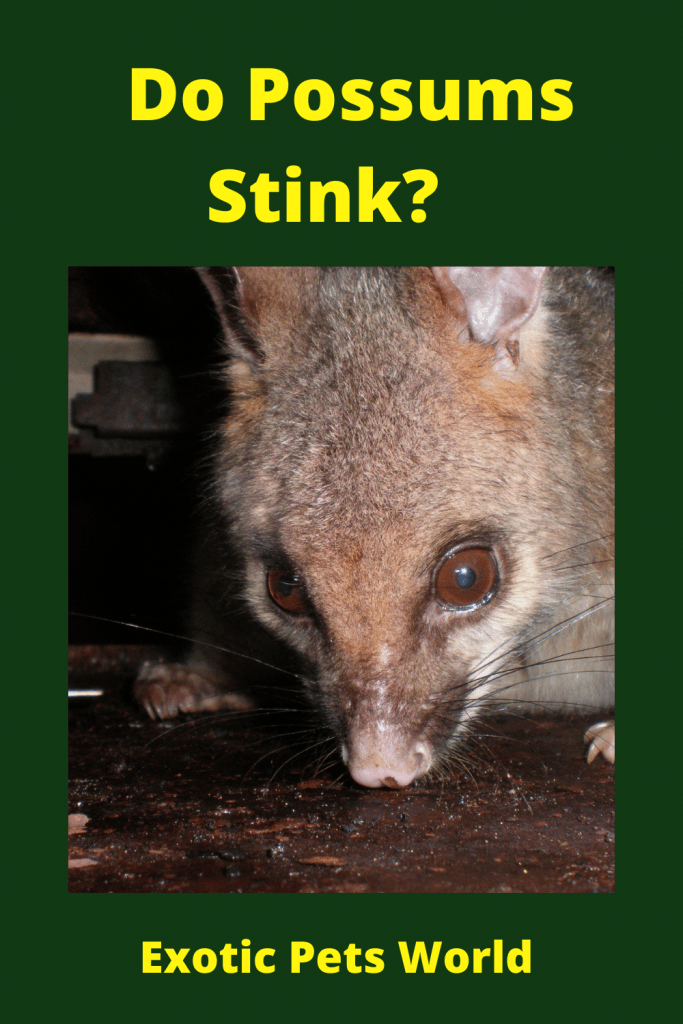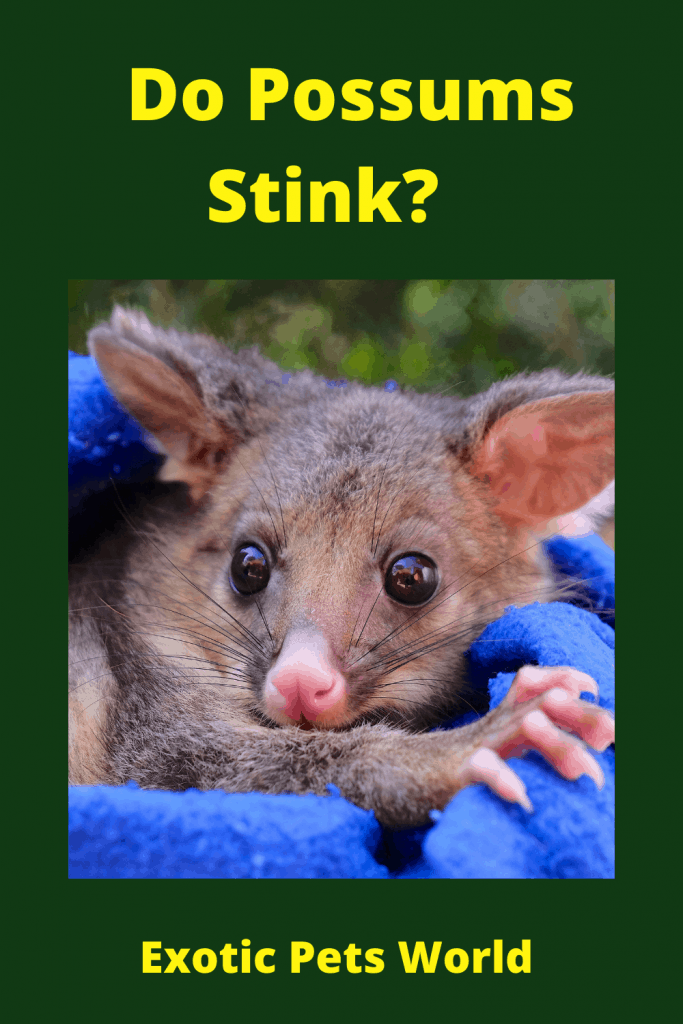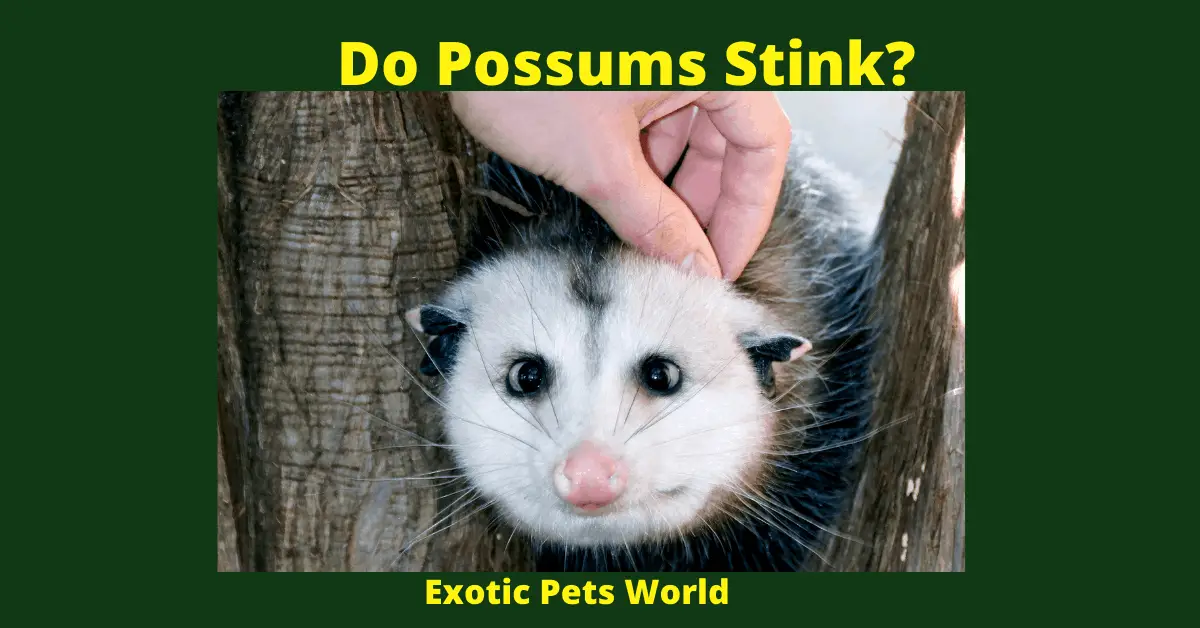The possum has dense body hair, a robust tail, two narrow yet round ears, and a thick snout. There are two variants in the breed, including several gaps like the animals. Possums are capable of hopping, leaping, and bounding to pass through trees. The scale and physical features of possums differ. The common possums are between ( 25″ – 37″ )65 and 95 cm in length and weigh ( 17 – 39lbs )8 to 18 kg.
Do Pet Possums Stink?
Possums are nocturnal and extremely adaptable species, able to survive nearly anywhere. They are already common in most places in the United States. The primary habitat is dense woodland, and podocarp-broadleaf forests are mainly inhabited.
The margins where wooded areas reach pastures are also typical habitats and host various wildlife species—possum stink to prevent animals from approaching. The scent of possums is part of their defensive process.
There are two methods to protect a possum from humans. They occasionally strike, or they tend to want to run away instead.
The possum has an inherent capacity to play dead if attacked or charged by predators. The prone posture will stay for an hour, depending on the duration of danger and seeking evidence that this is part of a reflex action originating in the opossum’s brain.
Another strategy the possum will use to warn their enemies when pretending to be dead is to secrete a green fluid from their rectal or anal glands. The stench can repel humans and predators alike and make skinks sound like they’ve found a dead or decomposing animal.
The opossum often employs the technique of drooling while playing dead. The glob of spit making the animal appears rabid.

Possum Defense Mechanisms
Playing Dead
The possum falls into an induced coma-like condition while presented with intense anxiety. Predators find the “kill” component of the stimulation useful for causing hunger; thus, an inactive possum provides little to enhance their appetite, and they would leave it alone. Somehow the possum’s body recognizes when the threat has gone, and the possum returns to the same place. Nature’s uncertainty!
Drooling
The possum will operate the jaw before overabundant saliva emerges then it will blow bubbles from its nose. Wet drooling leads the predator to suspect a possum is infected because it cannot kill it.
Alligator Mouth
Before possums have teeth, they can display a menacing facial expression. (The parents do not know that this is remarkable only until their children are willing to fight off predators.) This one behavior alone can drive all predators away (including humans).
Anal Gland Fluid
It is suspected anxiety will create a greenish-colored anal fluid. Possums cannot spray, and the only way they can contact you is to hit the anal region. It slips out effortlessly.
Are Possums Dangerous to Humans?
Possums can reach a medium dog’s size and have claws strong and sharp enough to open almost any kind of skin. They possess many sharp teeth.
Possums will open their mouth with their teeth bared and show their fangs to scare off predators and humans, but they don’t bite or attack. The hissing and growling may sound like an angry possum but is little more than a bluff. People are far more frightened of spiders than of them.
Keeping Possum as a Pet?
People sometimes care for and eventually adopt orphaned possums and consider them pets. It is not legal to keep such wild animals without a wildlife rehabilitation permit, but they should be released if they are healthy. They are wild animals who usually do not survive well in captivity. Attempting to turn a possum into a pet can be both stressful and costly.

Wildlife Rehabilitation
When keeping a captive possum legally, you are required to obtain a state wildlife rehabilitation permit. You may need to volunteer with a wildlife rehabilitator in specific locations, take a training class, or pass a written exam to obtain the license. When they are well and have recovered, they should be released. You might eventually find someone so sick they need continued care. If you have the requisite knowledge, experience, time, and finances, you might be able to adopt the possum as a pet.
What do Possums Eat?
The omnivorous possum is a voracious forager, consuming a diverse food source. He can add berries, herbs, leaves, and flowers, as well as snails and insects to his diet. He eats rabbits, kills rats, and avoids roadkill.
When he needs to consume something, he’ll eat it, too. It is incredibly challenging to build a captivity diet that can satisfy the nutrient requirements of wild possums, meets their nutritional needs, and preserves their calcium-phosphorus balance. A bad diet will contribute to type 2 diabetes and other costly conditions.
There are more than 60 different possum species, which include the most commonly found Virginia possum. As long as it is not treated as a pest, possums have a few good characteristics.
The characteristic of possums is their capacity to recall where food is found. They regularly resort to the same food sources.
In the field studies, possums did stronger on memory tests than humans, mice, rodents, and dogs.
With that information considering, precisely what do possums eat?
The Possums Diet.
The possum menu contains mice and reptiles, and insects for nutrition. They mainly eat chickens, plants, frogs, grain, and berries. A lesser-known reality regarding a possum’s diet is their requirement for large calcium concentrations. Due to this reality, possums readily consume roadkill animals that have been destroyed by automobiles.
Unfortunately, possums can even consume some form of food and may climb up to get it. It is not unusual to come into a possum in your rubbish bin.
It was Built for Scavenging.
Which foods do possums eat? Possums can consume about any food they can, whether in captivity or the wild. Availability of food is also not a concern because of the way they are designed and receive food.
Possums have weak eyesight but good ears and a heightened sense of scent. They are most successful at nighttime and travel rapidly in search of prey. They are made for digging and scaling, with sharp claws that are used for catching prey. Their tails are long, rendering them flexible in climbing.
Underage to Hunt.
While adults are capable of foraging, young possums are about the size of honey-bees. What precisely does a possum eat? Young possums can spend between six to seven weeks inside their mothers’ pouch before venturing into their own.
When consuming possums, rats, cockroaches, snails, and slugs are consumed by other animals on the cheerful hand, which may decrease these pests.

Life Span
Possums in the wild only have a brief lifetime of three years, or fewer, until they are targeted by predators and driven over by vehicles. With proper care, they will survive twice as long as they can in captivity. However, they might still be vulnerable to heat, lack of training, and a restricted diet, and as a result, you may invest in an animal that doesn’t last an extended period.
Health Problems
Possums are vulnerable to multiple pathogens, and their females often encounter contaminated genital and urinary tracts. Captive possums also have low immune systems and are more susceptible to some bacterial diseases. Possums who live more than one year are expected to grow cataracts, become fat, and show balance difficulties. Often vets struggle to get adequate care for their health conditions.
If you encounter a possum and plan to hold him as a pet, you can see a licensed vet to fix his underlying health complications.
Behavior and Temperament
The possum can become friendly or docile when it is approached.. Owing to their instinctual propensity to clash with other members of their genus, solitary animals are best. A cage mate may be violent and destroys another one.
They can be held cooped up for just a brief amount of time, and then only for breeding purposes. There tend to be no variations between the sexes when it comes to a pet cat or dog’s existence. All couplings are curious and polite.
Possums are marsupials that do not possess a pouch for rearing young. The young are born prematurely and cannot shift and latch onto a nipple on the mother’s abdomen.
They reside there until further grown. They are OK at being isolated but will break out of their enclosures. The possum is a nocturnal species, but it is not approved for children’s households.
Housing the Possum
Being so adept at fleeing, possums should be supplied with a safe habitat that is escape-proof. A tank with 20 gallons of water and a tightly-fitting lid should perform well. Hold the temperature of the enclosure at about 70 to 80 degrees. If Your Plan is breeding.
The possum should be supplied with bedding. Corn cob litter or shavings fit great for this project. A nest box is also needed but can be either an industrial, woven nest or plastic container such as a margarine tub. Nests would be formed with shredded paper (avoid inked newspaper) and tissue.
Perching and climbing branches are essential. They should be non-toxic and never handled with pesticides; parrot ladders and climbing toys are useful for possums. Additionally, a solid-surface hamster wheel may be used to create workout routines. Ensure the long tails do not get entangled in the system. They can enjoy building tunnels, creating cardboard boxes, digging flower pots, and other similar types of structures.
Possums are spotless animals and can typically use a corner of a cage to relieve themselves; put a litter pan in that corner to make washing the corner of the cage simpler. These animals are clean animals that require no treatment other than washing once a week.
If you Find Possum, What to Do?
In such conditions, it is advised that you can not touch a wild possum yourself. Millions of people worldwide are at risk of developing different diseases, including leptospirosis, measles, relapsing fever, tularemia, spotted fever, coccidiosis, trichomoniasis, and Chagas disease from possums.
They can bear numerous pathogens, including fleas, ticks, mites, and lice, which presents a health danger to both the general and veterinary industries. Handling a possum can present a risk or danger to you, your family, or your pets.
If you’re involved in finding a possum, instead of saving it, consult an animal rehabilitator. People with advanced hunting and trapping experience will help manage your land.
Can Possum Eat Fruits?
Possums will pick the rotten fruit because it is the most available to them. Keep possums out of fruit trees by pulling leaves, destroying walls, and damaging roofs to render them unavailable. Fill the trunk with sheets of different kinds of plastic and tape the sheets at the sides. This would discourage the possum from accessing the food. Rusty plastic garbage can do the trick.
Can I Get a Disease From a Possum?
A zoonotic disease is a disease that can be transmitted from livestock to humans. Some illnesses may be transmitted from animal to human, such as rabies. However, as long as you practice good judgment, you can not catch a disease from a possum. Do not try to stroke or approach the possum. According to the question and response above, rabies is exceedingly uncommon in the possum.

Do Possums Make Good Pets?
For starters, possums are on the top of the maintenance list. While dietary requirements are not fulfilled, they are a significantly elevated risk for serious and costly diseases to grow. Suppose you are unhesitatingly dedicated to obtaining a rehabilitator’s license and acquiring a possum.
Find a vet who has expertise in handling possums is critical. Another explanation is that not all know what to do with possums and what viruses they might contract. Besides costing money, they are wild animals. There are cases in which a docile possum can become a domesticated pet, but there are very few. Possums must have daily activity because they remain safe. A good keeper must go above and beyond.
Differences Between Opossum and Possum
The possum Trichosurus vulpecula was brought to New Zealand in the late 1800s as a socioeconomic significance species in the fur trade. This release was ineffective, and to create a second release at the same location 20 years later, a second release was needed.
It is common to hear people using the expression “possum” to refer to the North America opossum, but an Australian native may ask, “is it a possum?” The main reason being that these two individuals are entirely different. Both types of marsupials belong to the order didelphimorphia but the family phalangeridae.
Their appearance is much different from our common possum because the possum’s tail is covered in fur. Possums are in many color variations, and their ears are more significant and softer than the ears of the North American opossum.
Facts
- The marsupial lineage branched off from the other mammal lineage some 100 million years ago. Modern possums, kangaroos, and koalas are likely ancestral to each other, appearing about 20-30 million years ago.
- Jacks and jills, or the male and female genders, are called jacks, while a group is called an entourage.
- When living in Australia and nearby islands, encounters are more common as cities and towns have grown. Because of their inclination to live in dark places, they are considered pests and cause destruction and damage in gardens, farms, forests, and equipment. They are harmless by themselves but can be spread to humans and cause diseases by their sharp claws. If you contact an exotic animal, it is good to avoid contact and call animal control.
Possum Reproduction
Reproduction ranges from monogamy (a soul mate) to polygamy (a harem of mates) and nearly all in between.
Only the mountain brush-tail possum has the biological capacity to switch between heterosexual and homosexual mating processes depending on food supply. Males have loud calls that attract females and only mate with one female during the entire breeding season.
After the mating, the female lays one or two (rarely three) viable eggs, most likely to be applied between mid-March and early-June. Some species produce more offspring than others, but the vast majority of babies tend to die young. To live, the mother holds the young in her womb and the shelter of tree hollows or discarded bird nests. Some species do not construct their nests wholly from scratch.
Like humans, the female is the sole caretaker, while the parent contributes virtually little to their children’s survival. The ring-tailed possum is the only mammal species in which parenting is more pronounced in males than in females.
The gestation cycle is typically very manageable and short. The brush-tail possum only survives for 16 to 17 days in the wild. The joey emerges from its birth canal and crawls into its mother’s pouch so that it can continue feeding on her milk.
At this point, they are not yet hearing or seeing something, just a few millimeters long.
To be so highly dependent on the mother, the joey’s lips will fuse shut around the nipple at birth. And if the joey will become more stable, it will remain in its mother’s pouch for several months.
Eventually, the bag may become too large for the pouch and be moved to the neck’s back.
The possum achieves sexual maturity early relative to other mammals. Many creatures are slaughtered in the wild until they are old enough to die of natural causes, making a limited lifetime for them in the wild. They will survive longer in captivity, and it’s cooler there.
Final Thoughts
Possum can stink / smell badly in some ways. For, e.g., whether they feel suspicious about anything. They will go into a seizure condition and appear dead. They would then release a poisonous odor akin to death.
Possums stink and can strike in self-defense when threatened by an intruder. This is only observed while an animal truly believes it has no choice but to fight. Fighting will be their final form of preservation. Possums have paws they can hack with, but they are quickly torn off, but they cannot use them to protect themselves, except in self-defense. An opossum’s hands are small, so they prefer to ‘play dead’ to escape possible injury.

